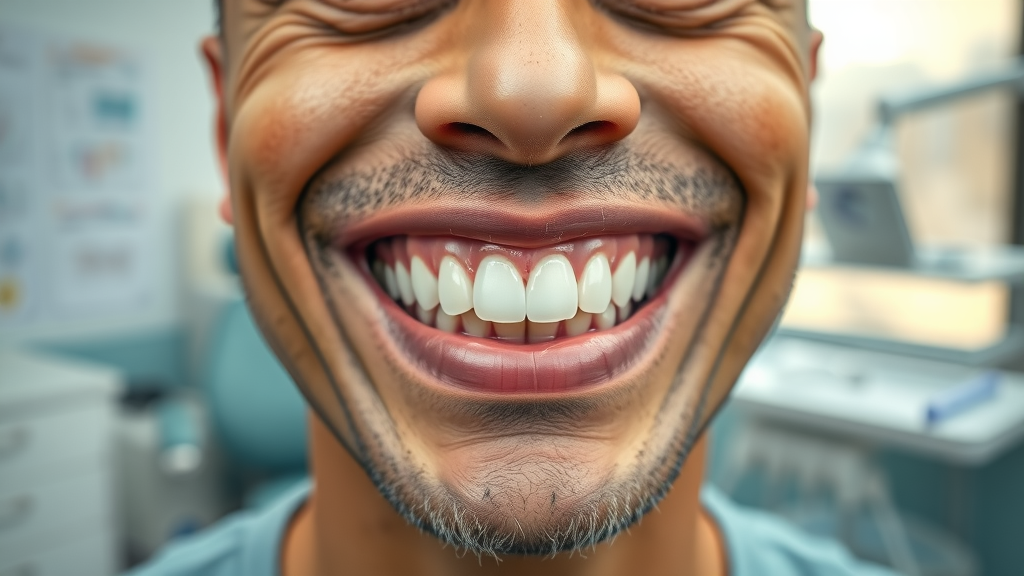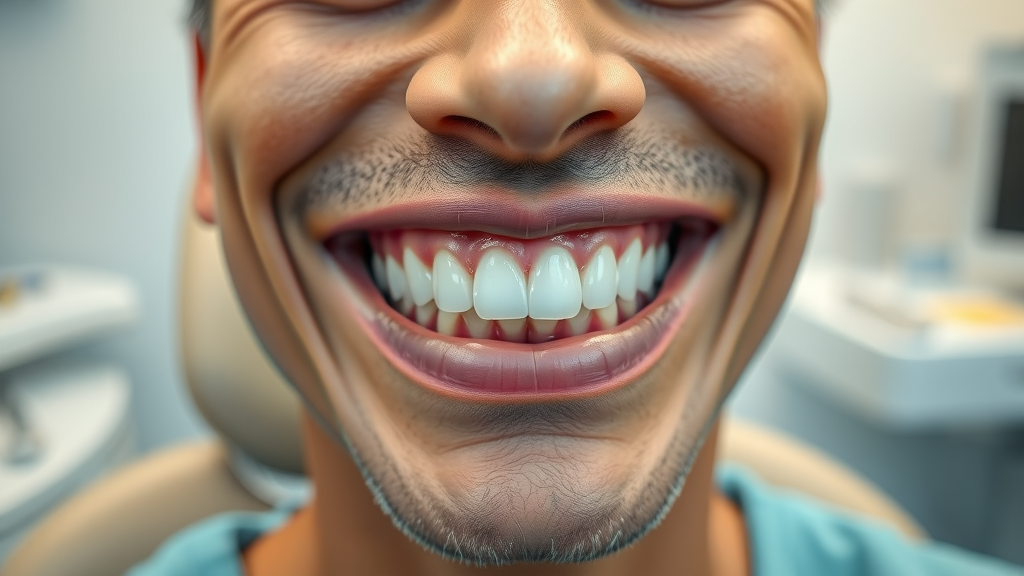Curious if Invisalign can straighten complex adult smiles that traditional braces typically treat? The answer may surprise you—modern advancements now put Invisalign to the test in far more challenging cases than ever before. Dive into the truth behind Invisalign’s power for complex situations, and discover if it could transform your unique smile.
Unlocking the Truth: Is Invisalign Effective for Adult Patients with Complex Cases?
When it comes to adult patients facing complex orthodontic cases, the options for treatment have expanded remarkably in recent years. For decades, traditional braces were considered the gold standard, especially for complicated alignment or bite issues. However, Invisalign—a clear aligner system—has made significant strides and now challenges conventional wisdom about what’s possible in orthodontic care for adults. But is Invisalign effective for adult patients with complex cases? Let’s explore what sets it apart, how it compares with other options, and whether it truly delivers results for grown-up, complex smiles.
Today’s orthodontists are using Invisalign to correct not just mild to moderate misalignment, but also many complex cases in adults—including severe overcrowding, deep overbites, crossbites, open bites, and more. The decision to recommend Invisalign or traditional braces depends on the individual’s dental anatomy, goals, lifestyle, and the complexity of the orthodontic issue. With technological advancements, digital treatment plans, and the expertise of qualified providers, Invisalign offers adult patients greater flexibility and discretion than ever before, sometimes matching or surpassing the outcomes of metal braces for select complex cases.
What You'll Learn in This Guide on 'Is Invisalign Effective for Adult Patients with Complex Cases?'
Overview of Invisalign and its innovations
Comparison with traditional braces for complex orthodontic cases
Understanding what defines a complex orthodontic case
Expert insights on candidacy, process, and outcomes for adults
Common misconceptions and critical considerations
Understanding Complex Orthodontic Cases in Adults
Adult orthodontic cases often differ from those in teens or younger patients due to several factors, such as mature bone structure, history of dental work, and greater likelihood of complex case patterns like severe crowding, gum disease, or substantial bite discrepancies. So what classifies a case as “complex”? The term typically refers to conditions that need advanced techniques, longer treatment time, or a combination of specialized tools to guide successful tooth movement.
Many adult patients present with multi-faceted challenges: overlapping teeth, previously untreated orthodontic issues, or prior dental interventions that can complicate a modern treatment plan. These factors used to leave plenty of adults with few choices outside of metal braces, but the landscape is now evolving. Understanding what makes a case complex is the first step to identifying the most effective treatment option.
Defining Complex Cases: What Constitutes a Complex Orthodontic Case?
In orthodontics, a complex case doesn’t just mean “hard to treat”—it’s a category of problems with a high degree of difficulty or requiring intricate treatment processes. These may include:
Common types of complex cases in adult orthodontics: Severe crowding or spacing, deep overbites, underbites, crossbites, open bites, rotated or impacted teeth, and combinations of these issues.
Clinical indicators for complex orthodontic and bite issues: Extensive shifts needed in tooth movement, problems that affect jaw position, and previous unsuccessful orthodontic treatments.
Diagnosing the degree of complexity involves digital scans, x-rays, and three-dimensional models of a patient’s mouth. For many adults, especially those who waited years or even decades to straighten their teeth, these challenges are more than aesthetic—they can also impact oral function and overall oral health.
Tables: Traditional Braces vs. Invisalign for Complex Cases
Feature |
Traditional Braces |
Invisalign |
|---|---|---|
Effectiveness for Complex Cases |
High, proven for all case types |
Effective for many (not all) complex orthodontic cases; improving with technology |
Treatment Time |
Often 18-36 months (varies) |
Usually 12-24+ months for complex cases |
Aesthetics |
Visible metal brackets and wires |
Nearly invisible clear aligners |
Comfort |
Possible discomfort from wires/brackets |
Smooth plastic, less soft tissue irritation |
Maintenance & Hygiene |
Challenging oral hygiene routine |
Removable for brushing, flossing, eating |
How Does Invisalign Work for Complex Orthodontic Cases?
Invisalign, as an advanced clear aligner system, approaches even the most demanding adult orthodontic cases with a custom, technology-driven approach. Unlike traditional braces—where metal brackets and wires are adjusted manually—Invisalign uses a series of removable, clear aligners, each shaped to move teeth incrementally according to a digital treatment plan.
With continuous improvements in digital imaging, computer-aided design, and aligner materials, Invisalign treatment is now utilized as a treatment option for more severe bite issues or tooth movement than ever before. For adult patients who prioritize aesthetics and convenience, this can be a huge benefit, provided the case falls within what Invisalign can handle effectively.
Clear Aligners Versus Traditional Braces in Complex Cases
Clear aligners like Invisalign have surged in popularity among adult orthodontic patients, especially for those seeking a discreet way to straighten their teeth. But do they really compete with the effectiveness of traditional braces for complex clinical problems? For years, metal braces held the advantage in terms of versatility. Brackets and wires can be finely adjusted to control every aspect of tooth movement, making them well-suited to handle even the most stubborn bite issues or multidimensional movements.
However, today’s Invisalign systems use more flexible, durable plastics and attachment points, allowing for significant improvement in how complex cases—such as rotations, extrusions, or even jaw alignment—are managed. While clear aligners may encounter challenges in treating certain types of severe malocclusion, the gap between these two approaches is narrowing fast. In many circumstances, Invisalign is now a valid alternative to traditional appliances, enabling more adult patients with difficult cases to achieve their ideal results while maintaining their lifestyle.
Treatment Process: Key Steps in Invisalign Treatment for Complex Cases
Initial evaluation and digital scan: The orthodontist captures a precise 3D image of your teeth and bite, which forms the basis for a digital treatment plan.
Developing an individualized treatment plan: Your orthodontist uses specialized software to map out each stage of tooth movement, accounting for bite issues and the specific needs of your complex case.
Aligner fabrication and progressive adjustments: A series of custom Invisalign aligners are created. You’ll switch to the next set every 1–2 weeks, gradually guiding teeth into position. Throughout the treatment process, periodic check-ups ensure that your case is progressing as planned and adjustments are made as needed.
"Complex orthodontic cases in adults demand tailored solutions. Invisalign's approach is more sophisticated than ever — Dr. Carter, Board-Certified Orthodontist"
Can Invisalign Treat Severe or Unique Orthodontic Problems?
For many years, the idea of using clear aligners for anything beyond mild or moderate misalignment was unthinkable. But now, Invisalign treatment is being employed for adults with complex orthodontic cases—often with impressive results. So, can Invisalign treat severe or unique issues? That answer depends heavily on the specific dental and bite problems, and the expertise of the treating orthodontist.
Severe crowding, complex bite issues (like overbites or crossbites), and even some cases involving jaw alignment can sometimes be managed with Invisalign, provided a meticulously designed treatment plan and high-quality aligner attachments. However, there are still limitations, and the best results are usually seen when orthodontists use a combination of digital planning, experience, and ongoing adjustments. Let’s look at some concrete examples and outcomes.
Complex Case Examples Treated with Invisalign
Cases with severe crowding: Carefully sequenced aligner sets and attachments can address crowding that previously required extractions and metal braces.
Overbite, underbite, and crossbite corrections: With precision attachments and elastics, teeth with complex bite dynamics can be improved, though extreme cases may still need traditional braces.
Relevant case studies and clinical outcomes: Studies show adult patients with moderate-to-severe malocclusion enjoying substantial corrections with Invisalign, especially when supervised by experienced orthodontists using advanced planning tools.
Watch how real adult patients faced complex orthodontic cases, chose Invisalign, and achieved life-changing results, guided by expert commentary and before/after visuals.
When Invisalign Might Not Be Suitable: Limitations and Challenges
While Invisalign’s capabilities are rapidly expanding, it’s essential to note the treatment is not a universal solution—some complex orthodontic cases are best managed by traditional braces, which can perform intricate movements clear aligners might not achieve with the same precision. For instance, cases involving major jaw discrepancies, certain impacted teeth, or significant vertical movements can present hurdles for the clear aligner method.
Additionally, Invisalign effectiveness relies heavily on strict patient compliance—aligners must be worn 20–22 hours per day. If a patient frequently removes or forgets their aligners, results and treatment time may suffer. Understanding these limitations is crucial to setting realistic expectations and ensuring successful treatment outcomes for adult patients with complex issues.
In Which Orthodontic Cases Is Invisalign Less Effective?
Some scenarios make traditional braces preferable or even necessary. These include:
Cases with severe skeletal discrepancies requiring jaw surgery
Extremely rotated teeth or teeth with short roots
Teeth that require vertical movement (raising or lowering)
Complex orthodontic cases where fine, multi-directional control of tooth movement is needed
Patients unable to maintain rigorous aligner wear schedules
Although Invisalign continues to evolve, it’s important for adult patients considering clear aligners for difficult cases to receive a comprehensive exam and hear an honest assessment from an experienced orthodontist.
Traditional Braces vs. Invisalign: Key Distinctions for Complex Treatments
Indications for traditional braces in complex orthodontic cases: Skeletal issues, impacted teeth, multiple types of tooth movement required at once, very severe crowding, or when patient compliance is a concern.
Type of complex orthodontic movements where clear aligners encounter challenges: Vertical movement, root torque, and dramatic bite correction.
It’s always key to weigh your priorities—whether that’s aesthetics, comfort, or maximum control over results—when choosing between Invisalign and other orthodontic solutions.
Invisalign Treatment Plan for Adult Patients: Customizing for Complexity
When treating complex orthodontic cases in adults, customization is critical. Successful Invisalign outcomes hinge on a detailed, personalized treatment plan created after thorough digital and clinical analysis. Experienced orthodontists utilize cutting-edge software to simulate every stage of tooth movement and anticipate challenges unique to adult teeth and bone structure. With this careful planning, even difficult cases can often be addressed with tailored aligners, attachments, and scheduled refinements.
Finally, the plan is delivered in a sequenced, stepwise manner—enabling progress checks, mid-course corrections, and use of additional appliances or elastics if needed. Consistent collaboration between patient and provider is essential to staying on course, especially for complex adult orthodontic cases.
Developing an Effective Treatment Plan for Complex Orthodontic Cases
Developing a robust treatment plan for a complex orthodontic case involves multiple steps. The orthodontist reviews x-rays, digital impressions, bite dynamics, and facial symmetry, designing a roadmap for moving each tooth with incredible precision. Attachments (small, tooth-colored bumps bonded to teeth) and elastics may be incorporated to increase the effectiveness of aligner therapy, mimicking the control once limited to brackets and wires.
This alignment-centric plan not only details each phase of the treatment process but also forecasts possible obstacles and alternative strategies if needed. Such individualized planning is what enables Invisalign to treat complex cases successfully for a growing number of adult patients.
Treatment Time and Compliance Considerations in Complex Invisalign Cases
Treating complex orthodontic issues with Invisalign can take 18 to 36 months or longer, similar to (or sometimes shorter than) traditional braces in the same scenario. However, treatment time for adults largely depends on the intricacy of the tooth movement required and, crucially, patient compliance. Invisalign aligners should be worn the vast majority of each day—removing them only for eating, drinking, and oral hygiene.
This level of responsibility isn’t always simple, especially in longer, more complex cases. Dedicated compliance ensures that each sequence of aligners works efficiently, reducing the risk of delays or setbacks. Consistent follow-ups with the orthodontist for adjustments, refinements, and troubleshooting also play a vital role in achieving the desired outcome.
"Patient compliance is crucial for Invisalign's success, particularly in complex adult orthodontic cases. – Dr. Greene, Orthodontic Specialist"
Oral Health and Hygiene: Unique Considerations for Adults with Complex Orthodontic Needs
For adult patients—especially those with complex orthodontic cases—maintaining excellent oral health during Invisalign treatment is paramount. Unlike traditional braces, clear aligners are removable, allowing easier access for brushing and flossing. This becomes a decisive advantage for individuals who may be at higher risk of gum disease or decay due to crowded, overlapping, or otherwise misaligned teeth.
That said, aligners must be kept clean to prevent bacteria buildup, and oral hygiene routines should be followed diligently. Invisalign encourages more frequent and thorough cleaning, which is beneficial for oral health during an extended orthodontic treatment process.
Importance of Oral Hygiene During Complex Invisalign Treatment
Oral hygiene is an ongoing commitment for all orthodontic patients, but it takes on special significance during Invisalign therapy for complex cases. Because aligners fit snugly over the teeth, any residual food or plaque is trapped directly against enamel and gum tissue. Without meticulous cleaning after every meal, there’s a higher risk for cavities or gum inflammation.
Best practices include brushing and flossing after snacks and meals, rinsing and cleaning aligners daily, and regular dental hygiene checkups. The removable nature of clear aligners makes it easier to sustain these healthy habits compared to brackets and wires, meaning your smile stays healthier while it’s being transformed.
Orthodontic and dental experts share actionable tips for safeguarding gum and tooth health while undergoing Invisalign for difficult cases.
People Also Ask: Expert Answers on Invisalign for Complex Cases
Can Invisalign fix complex cases?
Yes, Invisalign can address many complex orthodontic cases in adults, including severe crowding, deep overbites, crossbites, and open bites—if planned by an experienced orthodontist. However, not every complex case is suitable for aligners; some scenarios may still require traditional braces for the best results.
Can Invisalign be used for severe cases?
In selected severe cases, Invisalign can be highly effective, especially when augmented with attachments, rubber bands, and other advanced planning. Extreme situations, such as significant jaw shifts or certain types of impacted teeth, may still favor traditional solutions. A thorough professional assessment is essential to determine suitability.
In what cases will Invisalign not work?
Invisalign is less effective in cases requiring major jaw repositioning, certain vertical tooth movements, or when patient compliance is uncertain. Impacted teeth that need to be surgically repositioned, or cases requiring multi-faceted orthodontic interventions, might be better managed with traditional braces or a hybrid approach.
What is considered a complex case for Invisalign?
A complex Invisalign case usually involves severe malocclusion, significant overcrowding or spacing, challenging bite issues (overbite, underbite, crossbite), rotated or impacted teeth, or situations where multiple movements are required simultaneously. These cases require an expert’s oversight, precise planning, and possibly supplementary orthodontic tools.
Frequently Asked Questions: Is Invisalign Effective for Adult Patients with Complex Cases?
How long does Invisalign take for adults with complex orthodontic cases?
Complex cases in adults may require 18–36 months, sometimes longer depending on the degree of correction needed. Compliance with aligner wear is a significant factor in staying on track.Are clear aligners more comfortable than traditional braces in complex scenarios?
For most adults, Invisalign aligners are more comfortable since there are no wires or metal brackets that can cause inner mouth irritation. However, initial tightness or pressure is still common as teeth are guided into place.Is the cost of Invisalign different for complex cases versus routine cases?
Yes, treating complex orthodontic issues with Invisalign often involves more aligners, longer monitoring, and increased expertise, typically leading to higher costs than routine cases. Your orthodontist can provide an accurate estimate based on your specific needs.
Watch board-certified orthodontists discuss candidacy, challenges, and outcomes for adults choosing between Invisalign and traditional braces for complex orthodontic problems.
Key Takeaways: Is Invisalign Effective for Adult Patients with Complex Cases?
Invisalign can address many complex orthodontic issues in adults but requires expert planning and patient compliance
Certain cases still demand traditional braces for best outcomes
Patient education is crucial for lasting success with complex Invisalign treatment
Conclusion: Making Informed Choices About Invisalign for Complex Adult Orthodontic Cases
Consult a skilled orthodontist to assess your unique needs and goals—today’s solutions may surprise you.
Subscribe Now for Trusted Orthodontic Insights!
Subscribe now to get the latest Grand Strand orthodontic guides, tips, and updates — right to your inbox. No spam. Just smiles.
Invisalign has evolved significantly, now effectively addressing many complex orthodontic cases in adults. Advancements in clear aligner technology, such as SmartTrack® material and precision attachments, have expanded its capabilities to treat severe crowding, overbites, underbites, crossbites, and open bites. (clementeorthodontics.com)
However, Invisalign may have limitations in cases involving significant jaw misalignments or severe tooth rotations. In such instances, traditional braces or a combination of treatments might be more appropriate. (deandentalsolutions.com)
The success of Invisalign in complex cases also depends on patient compliance, as the aligners must be worn for 20-22 hours daily. Regular consultations with an experienced orthodontist are essential to determine the most suitable treatment plan for individual needs. (miamiorthodontistgroup.com)
In summary, while Invisalign offers a discreet and comfortable option for many adults with complex orthodontic issues, its effectiveness varies based on the specific case and patient adherence to the treatment regimen.
 Add Row
Add Row  Add
Add 




Write A Comment